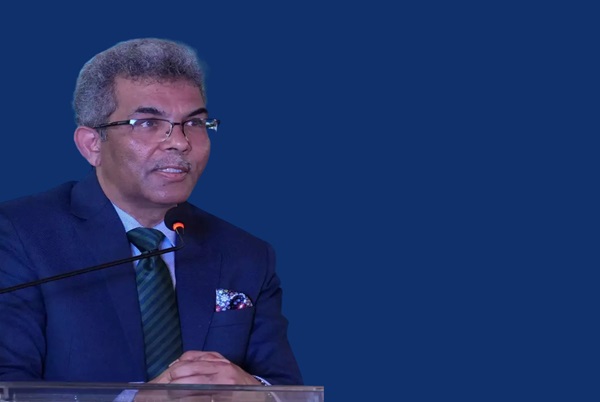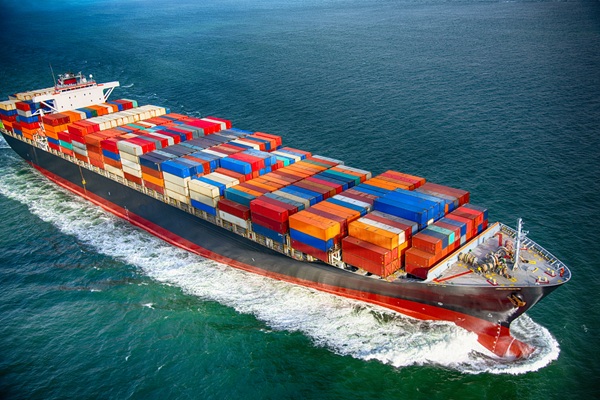.png)
Big GST Reforms Likely In 6 Months, Says Vivek Johri
Eight years after rollout, India’s GST remains a transformative but unfinished project. Vivek Johri talks about its achievements, gaps, and what’s needed to complete the reform.


Ranjana Chauhan is a senior financial journalist. She brings sharp focus on the softer aspects of business and enjoys writing on diverse themes, from the gender lens to travel and sports.
April 28, 2025 at 2:46 PM IST
Eight years after its launch, India’s Goods and Services Tax remains a work in progress--transformative, yet unfinished. GST promised a unified market, simpler compliance, and greater transparency. While much ground has been covered, key promises are still pending. Momentum is building, however, for some critical reforms to take shape within the next six months.
To assess GST’s journey and the bold fixes it now needs, BasisPoint Insight spoke with Vivek Johri, former Chairman of the Central Board of Indirect Taxes and Customs. A key architect of GST’s design and rollout, Johri--now Senior Advisor for Indirect Taxes at KPMG in India--offers a candid assessment, rating the indirect tax regime a cautious 6.5 on 10, and outlines a clear roadmap for course correction.
Below are edited excerpts from the conversation*:
How would you rate GST on a scale of 10 – from what it set out to achieve versus where it stands today?
I would rate it at 6 or 6.5, and I’ll tell you why. One of the major reasons why we went into GST was to integrate the national market. There were boundaries across states for the trade of goods and services, and that was a big challenge. Those boundaries are now gone - so full marks on that.
Removal of cascading was another objective. Linked to that was the transparency of tax incidence. To a great extent--because so many taxes have been rolled into one and there is Input Tax Credit available, not just across goods and services but also across the country and both for CGST and SGST--there is a fair amount of achievement in terms of removal of cascading and transparency of incidence. A consumer who's paying tax at the end of the day knows exactly how much tax a particular goods or category of services bears.
The third factor is simplified compliance with taxpayers... I would not give full marks there. There are a lot of challenges with that because of a dual GST that India adopted owing to its federal structure.
Two other areas that call for work are in reducing disputes and improving revenue buoyancy. There is also room for improvement in revenue efficiency.
Input Tax Credit is a persistent pain point for businesses. Your view?
In an ideal GST system, there should be no impediments to flow of ITC. Actually, the problem is not so much with regard to failure to upload invoices, which is leading to denial. It has more to do with fake invoices and fake ITC that has been a challenge and one of the downsides in GST implementation.
And with regard to that, in all fairness, measures have been taken. For example, we have a system of invoice management that has been introduced recently. So, if there are any failures on the part of a supplier in either declaring the details of an invoice, those can be fixed through the invoice management system. Also, they introduced a return called GSTR 1A. If the supplier himself realises there has been some gap in uploading invoices for a particular period, he has a short window within which he can rectify that. So, while measures have been taken on ITC, it's still not perfect.
GST law had envisioned a National Appellate Tribunal to ensure uniformity in rulings. This has still not seen the light of the day. What are the roadblocks and where is the proposal now?
The major roadblock was on its composition – a balanced representation of the judiciary and technical members. That has now been resolved - the GST Council decided that every bench would have two judicial and two technical members. There have also been some legal challenges to the way the tribunal has been constituted. I believe those have also been resolved.
The current challenge is the desire to adopt a completely IT-enabled process. And that would require some software development, at the backend and the frontend. These are days when you have electronic or remote hearings... It's an ambitious project from that point of view. That, and the creation of infrastructure, is what is holding it back.
According to news reports, the president of the GST Appellate Tribunal has already been appointed. I'm told some members for the central benches have also been appointed, but the appointment of other members is underway. I’m hopeful that the tribunal would be in place in the next five to six months.
One of GST's promises was a ‘one nation, one tax’ regime. In practice, we've seen states diverge, be it in e-way bill enforcement or contradictory advance rulings. Is this a design flaw or a coordination issue? Is it time for a central advance ruling authority for GST?
Firstly, I think the problem with divergence of interpretations and enforcement of law can happen even in a unitary system. But there is a fundamental design flaw, if one could call it that, in going into a dual GST. In many countries that have a federal system, one of the two, either the federal government or the state, collects the tax on behalf of both so that the taxpayer has to deal only with one administration at a time.
Now here, the problem is compounded because you have a dual GST and each state is independent in enforcement and in the day-to-day operations. So, for the taxpayer, particularly those with a national presence, this is a big challenge. Advance rulings were envisaged to iron this out but the experience has not been so good because of the divergence between states in the interpretation of the same issue. I think there is a resolution possible. The trade-off here is that if you have a national-level advance ruling authority to bring convergence in views, it becomes costly for taxpayers to access it. We had that model in customs earlier, and we've decentralised it slightly so that there's more than one advance ruling authority available to taxpayers.
And that is why, in GST, we began with the state-level authority. But if you want to iron out differences across advance ruling authorities, we could follow the European model for their customs laws, which is called the binding tariff information. The entire procedure is IT-enabled and an authority in one country in the EU is prevented from taking up an issue that another authority has already pronounced on or is examining. This minimises the possibility of divergences in practice.
As for day-to-day operations of GST, we need better coordination between the Centre and the states. Eventually we'll have to evolve into a system where at least the key taxpayer-facing processes--such as audits and investigations--would be manned by verticals comprising both the Centre and the states at a national level to ensure uniformity of approach.
Now for the most common criticism of GST. We have five major GST rates, plus cesses. What's holding back the plan for simplification?
It’s the concern about revenue and how to keep the exercise revenue-neutral. We've had a Group of Ministers in place from 2021 to look at rate rationalisation. At that time, the concern the states had was that the GST compensation cess was going to go away and they wanted the GoM to look at ways to ensure that the revenue buoyancy was maintained post the compensation cess. The GoM was tasked to recommend the path on removal of exemptions and ways to broaden the base. That part is complete, the report was accepted by the GST Council, and operationalised.
The second part of the task was more difficult--to compress the number of rates in GST - because the more the rates, the higher the chance of disputes and arbitrage. This is not an ideal system for the taxpayers as well as the government. But the challenge is, if you have to compress rates, some rates have to go down. In the past, discussions have floated around a rate of 15-16% because that was perceived to be the revenue-neutral rate. If that is where we need to go, then the standard rate of 18%, which fetches you almost 65% of your revenue today, needs to go down. Even if it goes down by two percentage points, the revenue loss that you incur will be quite substantial. You will not be able to make that up simply by doing away with the 12% slab because it doesn't fetch you that much revenue.
One way of looking at it is that if you moderate the rates, the experience worldwide and even in India has been--and you have the income tax example to go by--the compliance improves. Therefore, over a period of time, revenue will make up. But then, are we willing to wait for that? Are we prepared to take a short-term hit in the interest of the long-term benefit?
I think those are the questions that would be troubling the minds of the GoM. And that is why it is taking time for them to come out with the report. Another issue linked to this is the fate of the compensation cess, which is being looked into by another group of ministers. That group has also yet to turn in its report.
The level of ambition with regard to rate rationalisation is linked directly to what happens to the compensation cess. If the compensation cess is there to stay, the appetite for doing a rate rationalisation may actually go down... So that is another imponderable at the moment.
But I think we are nearer to a three-rate structure, and my sense is that the GoM will find a means of balancing revenue--even if there is a marginal loss of revenue in the short run.
In this backdrop, the finance minister had recently hinted at lowering the GST burden for taxpayers. Given the fiscal pressures and compensation dues to states, is this viable?
It depends on the balancing act... if you are prepared to increase the lower rate of GST--which is currently 5%--and 12% goes up to whatever is the standard rate; plus you're able to identify some demerit goods and enhance their rate from 28%... There are ways of doing it.
Petroleum, a major product segment, remains outside GST. Why? Politically too sensitive or fiscally too risky for states?
It's a little bit of both. But it is not as if a solution is not available. There are many global instances of a GST on petroleum products or a VAT-like tax. What that does is it removes cascading in the economy and to recoup the revenue loss there is a supplementary excise or a sales tax. A similar solution is possible in India, and a beginning must be made somewhere.
One of the things that will make it easier for us to do a meaningful exercise of rate rationalisation would be to expand the base. For petroleum, fortunately, there is a constitutional and a legal provision already available. And the GST Council only has to determine on what date it kicks in. The more you go in for base expansion, the possibility of lowering the rates is that much better.
I recall that the Finance Commission chaired by Dr Kelkar had said in an internal report that if the entire tax base--electricity, petroleum, alcohol, property sale, etc--were brought under the GST net, and if you were to go in for a single rate of GST, the number could be as low as 5-7%! That is the order of difference that base expansion can make.
To wrap up, what are your top reform priorities for GST?
There are two things that need to happen right away. One is the setting of the GST Appellate Tribunal. Without it, dispute resolution is tilted against small taxpayers. Access to courts should be a last resort.
The second and very vital reform is rate rationalisation. Going by statements of the finance minister herself, this appears to be well underway. We should see the outcome over the next five to six months. And it's not necessary to do everything in one go; it's possible that the Council decides to do it in a phased manner. But a beginning must be made.
The third thing that needs to be done, but which is slightly medium-term, is improving the coordination and definition of processes within the GST, and quality assurance reviews of circulars.
The final suggestion is for more aligned business processes, such as audit or dispute resolution, between the Centre and states. And of course, we need more investment in training and capacity-building, and also promoting specialisation in certain industries.
*Views expressed by Johri are personal.



